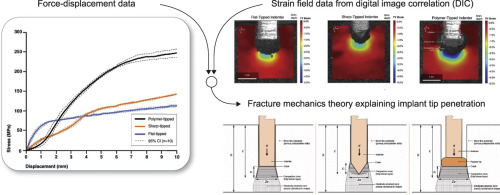Journal of the Mechanical Behavior of Biomedical Materials ( IF 3.3 ) Pub Date : 2018-02-03 , DOI: 10.1016/j.jmbbm.2018.01.025 Sloan A. Kulper , K.Y. Sze , Christian X. Fang , Xiaodan Ren , Margaret Guo , Kerstin Schneider , Frankie Leung , William Lu , Alfonso Ngan

|
Many features of orthopaedic implants have been previously examined regarding their influence on migration in trabecular bone under axial loading, with screw thread design being one of the most prominent examples. There has been comparatively little investigation, however, of the influence that implant tip design has on migration under axial loads. We present a novel fracture mechanics model that explains how differences in tip design affect the force required for axial penetration of porous, compressible solids similar to trabecular bone. Three tip designs were considered based on typical 5 mm diameter orthopaedic locking screws: flat and conical tip designs, as well as a novel elastomeric tip.
Ten axial penetration trials were conducted for each tip design. In order to isolate the effect of tip design on axial migration from that of the threads, smooth steel rods were used. Tip designs were inserted into polyurethane foam commonly used to represent osteoporotic trabecular bone tissue (ASTM Type 10, 0.16 g/cc) to a depth of 10 mm at a rate of 2 mm/min, while force and position were recorded. At maximum depth, elastomeric tips were found to require the greatest force for axial migration (mean of 248.24 N, 95% Confidence Interval [CI]: 238.1–258.4 N), followed by conical tips (mean of 143.46 N, 95% CI: 142.1–144.9 N), and flat tips (mean of 113.88 N, 95% CI: 112.2–115.5 N). This experiment was repeated in cross-section while recording video of material compaction through a transparent window. Strain fields for each tip design were then generated from these videos using digital image correlation (DIC) software.
A novel fracture mechanics model, combining the Griffith with porous material compaction, was developed to explain the performance differences observed between the three tip designs. This model predicted that steady-state stress would be roughly the same (~ 4 MPa) across all designs, a finding consistent with the experimental results. The model also suggested that crack formation and friction are negligible mechanisms of energy absorption during axial penetration of porous compressible solids similar to trabecular bone. Material compaction appears to be the dominant mechanism of energy absorption, regardless of tip design. The cross-sectional area of the compacted material formed during migration of the implant tip during axial penetration was shown to be a strong determinant of the force required for migration to occur (Pearson Coefficient = 0.902, p < .001). As such, implant tips designed to maximize the cross-sectional area of compacted material – such as the elastomeric and conical tips in the present study – may be useful in reducing excessive implant migration under axial loads in trabecular bone.
中文翻译:

一种新颖的断裂力学模型,解释了各种骨科植入物尖端对骨状多孔可压缩固体的轴向渗透
先前已经检查了骨科植入物的许多特征,这些特征对它们在轴向载荷下对小梁骨迁移的影响有关,其中螺纹设计是最突出的例子之一。然而,关于种植体尖端设计对轴向载荷下迁移的影响的研究相对较少。我们提出了一种新颖的断裂力学模型,该模型解释了尖端设计的差异如何影响类似于小梁骨的多孔可压缩固体轴向渗透所需的力。基于典型的5毫米直径的骨科锁定螺钉,考虑了三种尖端设计:扁平和锥形尖端设计,以及新型的弹性体尖端。
每个针尖设计进行了十次轴向渗透试验。为了将尖端设计对轴向迁移的影响与螺纹分离开来,使用了光滑的钢棒。将尖端设计以2 mm / min的速率插入10毫米深度的通常用于代表骨质疏松小梁骨组织(ASTM类型10,0.16 g / cc)的聚氨酯泡沫中,同时记录力和位置。在最大深度处,发现弹性尖端需要最大的轴向移动力(平均值为248.24 N,置信区间[CI]:95%:238.1–258.4 N),其次是锥形尖端(平均值为143.46 N,CI为95%: 142.1–144.9 N)和扁平尖端(平均113.88 N,95%CI:112.2–115.5 N)。通过透明窗口记录材料压实的视频时,在横截面上重复该实验。
开发了一种新颖的断裂力学模型,将格里菲斯与多孔材料压实相结合,以解释三种尖端设计之间观察到的性能差异。该模型预测,在所有设计中,稳态应力将大致相同(约4 MPa),这一发现与实验结果一致。该模型还表明,在类似于小梁骨的多孔可压缩固体轴向渗透过程中,裂纹的形成和摩擦是能量吸收的微不足道的机制。无论尖端设计如何,材料压实似乎是能量吸收的主要机制。种植体尖端在轴向穿透过程中的迁移过程中形成的压实材料的横截面面积显示,是迁移发生所需力的重要决定因素(皮尔森系数= 0。902,p <.001)。因此,旨在最大程度地压紧材料的横截面的植入物尖端(例如本研究中的弹性体和圆锥形尖端)可能有助于减少在骨小梁的轴向载荷下过多的植入物迁移。











































 京公网安备 11010802027423号
京公网安备 11010802027423号